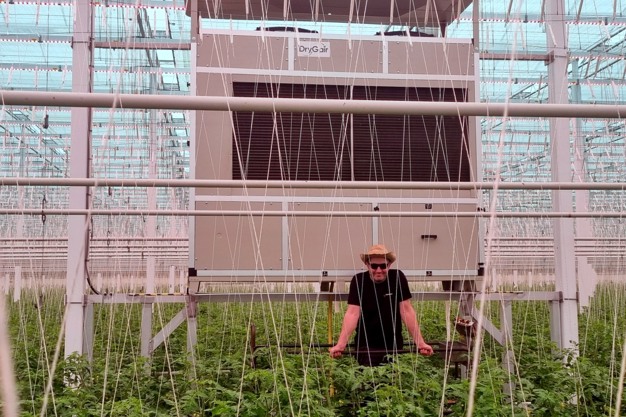Miljøgartneriet is Norway's largest vegetable producer, growing tomatoes, cucumbers, and peppers, on close to 8 hectares of advanced, high-tech glasshouses. Specializing in sustainable and environmental production, head grower, Simon Hansen, decided to invest in LED lighting and DryGair dehumidifiers in 2020. He has since seen significant changes in energy expenses, as well as in his yields.
Environmentally friendly growing
Prior to growing tomatoes in Norway, which tomato grower Simon Hansen has been doing for 12 years now, he already grew tomatoes in Denmark, for approximately 17 years.
Remarkable about Miljøgartneriet is the name directly translates to 'environmentally friendly growing'. And it's not just words, Simon shows. "We don't have our own heating center. We work with Norway's largest dairy farm, which is our neighbor. They have a surplus of heat, so instead of letting that out, we use it in our greenhouse. It's only when it's really cold, and very windy, that I need extra heat. They also supply us with their CO2 waste. It's sort of a symbiotic relationship, like bacteria around a plant root. We are both happy, and we profit of each other."
Miljøgartneriet is divided into 8 greenhouses and a propagation facility, almost one hectare each, as the company raises young plants in their propagation facility. "It's quite a modern greenhouse built by KUBO, with very high roofs", Simon shows. "We have climate screens in all the greenhouses, so we also save energy that way." The company grows year-round on 3.5 hectares. "We grow in cycles – the tomatoes are switched out for cucumbers during the winter."

LEDs
In 2020, Simon decided to install LED lamps across 3.5 hectares of greenhouses. "Before that, our production was seasonal. But the demand for more and more products during the wintertime made it clear that we should begin growing year-round", he explains. In wintertime, the company now grows cucumbers on 2.5 hectares, and tomatoes on 1 hectare.
"The first year of growing with the LED lights, we didn't have any dehumidifiers, though we already knew we would need them. We simply couldn't do everything in one go", he says. "To be honest, it was a nightmare. We managed to grow, but it was very hard. The climate was very irregular, because of the enormous amount of transpiration from the plants, under the LEDs."
That's where DryGair came into the picture, of course with their dehumidifiers. "The year after, we installed the DryGair units. It was a whole different world – steerable, controllable, beautiful plants, beautiful products. After seeing the results, we took the final step and installed DryGair in almost all of our greenhouses, including those without the lighting. Today, we have a total of 39 DG-12 units in our facility."
The team found that DryGair was a very reasonable solution, especially because it was easy to install. "You install the DryGair units, connect them to electricity, and you start dehumidifying immediately. And I should also mention that Poul Erik Andersen, of Steenbek A/S, also made it very simple, friendly, and did an excellent job."
Difficulties
So what's behind this enthusiasm? Scandinavian growers have to deal with some usual difficulties, including botrytis, bad climate, bad growth, and high energy prices. "But that's all been eliminated after we installed the DryGair units", says Simon. "With DryGair, we have a much more even climate. That's one of the things I'm looking for – an even climate and even transpiration during the whole period of the day when the plant grows. Using DryGair, we have much better plant health, because you can keep your ventilation on and the roof shut. You can keep your curtains spread, create a stable climate, and keep your carbon dioxide inside the greenhouse. This is really good for the plants, and really good for your yield, as well as the quality of the products."
The company no longer has to deal with fungal problems anymore. "Last year, we didn't have any issues. Zero."
"Overall, it's clear that you get a healthier and more even crop. If you have a wish for the way you want your crop to be, it's easier to get there with DryGair. You have better control over your environment, you can keep your temperature and humidity more even. This all creates a better balance in your plants", he summarizes, and, taking cherry tomatoes for example: "Overall, it's clear that you get a healthier and more even crop. If you have a wish for the way you want your crop to be, it's easier to get there with DryGair. You have better control over your environment, you can keep your temperature and humidity more even. This all creates a better balance in your plants."
Energy
Growing tomatoes using dehumidification is known to immediately reduce your costs, simply because you can close your ventilation frames on the roof of the glasshouse. The DryGair units take care of the dehumidification. Without dehumidification, as much as 60% of your total heating costs are actually for controlling humidity. "So, right away, you have huge cost savings when using DryGair", says Simon. "I always say, the actual savings depend on what you grow, where you grow, and how you grow it. But it's certainly between 30%-60% in Scandinavia: before DryGair we used more ventilation to remove moisture, and our energy expenses were definitely high."
Other benefits
Of course, the energy savings and environmental impact are great - but Simon says he got a whole range of other benefits as well. "For example, it's much easier to keep a high concentration of CO2 in your greenhouse, leading to higher production and healthier plants. When you vent, you let the CO2 out, which is inefficient. Especially if you pay for CO2, it's a huge disadvantage to let it out through your roof."
He adds it helps optimize working hours as well. "You want to prune the plants when they're dry, rather than moist. This helps prevent botrytis, it's old knowledge. So having dry leaves in the morning lets my workers start earlier when it's cool and not so sunny."
Return on investment (ROI)
When asked about the ROI, Simon says it depends on the energy price, of course. "We installed the first round of units three years ago, and they're all paid off now. Now they're just there, giving me a healthy, even crop, and saving me more money."
Another aspect, which leads back to the energy situation, is that he wants to avoid purchasing high degree heating from the dairy farm. "When their waste heat isn't sufficient, they produce heat especially for me, and that's very expensive, almost double the cost. With DryGair I manage to avoid that more than before. Now, having the roof shut and screens spread for as long as possible, I get much more out of the waste heat."
Steering
So does he uses DryGair differently in different seasons, or in the nighttime vs. daytime?
"Well, the units do so themselves", Simon says. "If there's no need for them, the compressors switch off. I don't have to do anything. That's what I need."
Yet he sees there's a big difference in how you grow with or without DryGair. "The way you steer the crop is very different. During the day, they can switch the compressors on if there's a need for it. However, if I ventilate during the day, it's only because of excessive heat in the greenhouse, not due to moisture. With DryGair, instead of venting at, say 1, or 1.5 degrees above the heating setpoint, I have my ventilation setpoint higher. So, I use a relative controlled minimum ventilation position to steer the temperature as even as possible. So, I use a minimal amount of venting to steer the temperature."
Too much ventilation gives you an irregular crop, he says. "That's a big benefit of DryGair." Yet, at the same time, DryGair's circulation fans stay on even when the compressor is off. "The extra air circulation is a benefit for the plant. It creates air movement, leading to maximum crop transpiration. For me, the most important thing is transpiration. You want to maximize transpiration. If not, you're not growing optimally and not maximizing production potential."

For more information:
DryGair
www.drygair.com
Steenbek
https://steenbek.dk/
Miljøgartneriet
miljogartneriet.no/
